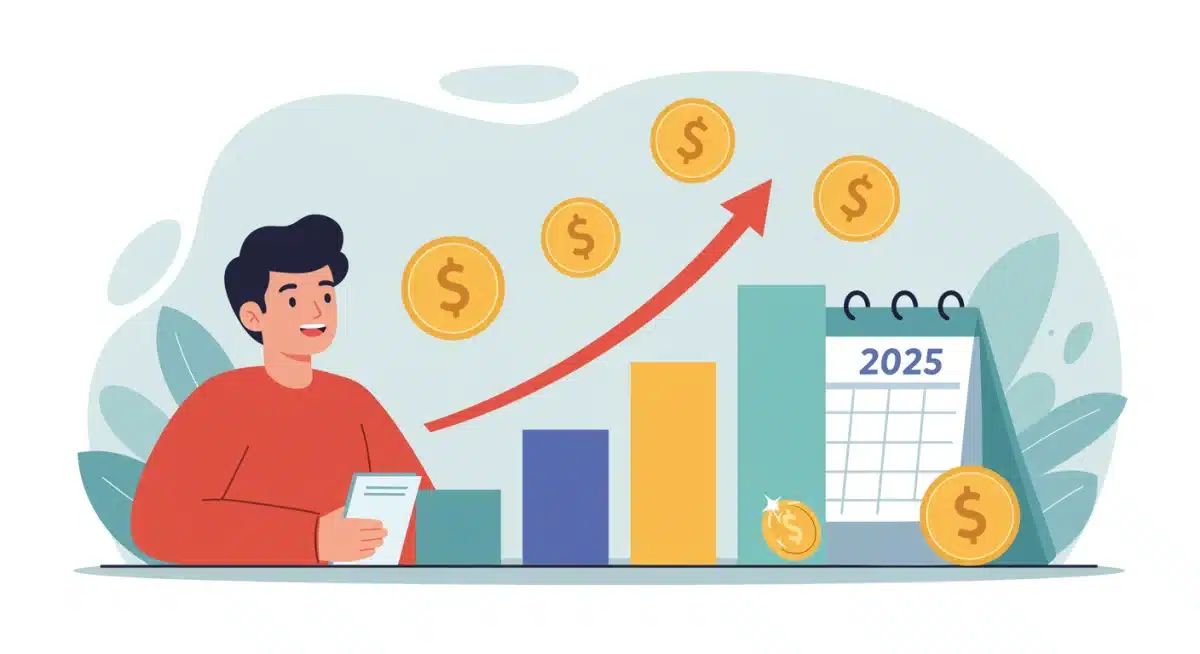Maximizing Retirement Contributions: New 2025 Limits & Tax Advantages

Understanding the new 2025 retirement contribution limits and their associated tax advantages is crucial for optimizing your financial future, ensuring you leverage every opportunity for long-term financial security.
For many Americans, planning for retirement is a cornerstone of financial stability. The ability to effectively save and invest for your golden years hinges significantly on understanding the available tools and their evolving parameters. This article delves into Maximizing Retirement Contributions: New Limits and Tax Advantages for 2025 Explained, providing an essential guide for individuals aiming to optimize their retirement savings.
Understanding the Importance of Retirement Contributions
Retirement contributions are not merely about setting aside money; they are about strategically building a future free from financial worry. The power of compounding interest, combined with tax-advantaged accounts, can transform modest regular contributions into substantial wealth over time. This foundational understanding is the first step toward a secure retirement.
Many individuals underestimate the cumulative effect of consistent contributions, especially when starting early. Even small amounts, when invested wisely and consistently, can grow exponentially thanks to the magic of compounding. This makes every contribution, particularly those made to tax-advantaged accounts, incredibly valuable.
The Compounding Effect on Your Savings
The compounding effect is a critical concept in retirement planning. It means that your investments earn returns, and those returns then earn their own returns, creating a snowball effect. The longer your money is invested, the more significant this effect becomes, highlighting the advantage of early and consistent contributions.
- Early Start: Beginning contributions in your 20s or 30s allows decades for compounding to work its magic.
- Consistent Contributions: Regular deposits, even small ones, maintain momentum and maximize growth potential.
- Reinvesting Earnings: Allowing dividends and capital gains to be reinvested further accelerates the compounding process.
Understanding the importance of these contributions helps frame why staying updated on new limits and tax advantages is so vital. It’s not just about compliance; it’s about making your money work harder for you.
New 401(k) and 403(b) Contribution Limits for 2025
As we look towards 2025, it’s crucial for employees and employers alike to be aware of the updated contribution limits for employer-sponsored retirement plans like 401(k)s and 403(b)s. These adjustments, typically made annually by the IRS, reflect economic changes and inflation, offering new opportunities to save more for retirement on a tax-advantaged basis.
These limits dictate the maximum amount you can contribute to your retirement accounts each year, excluding employer contributions. Staying informed about these figures ensures you can plan your contributions effectively and avoid inadvertently exceeding the caps, which could lead to tax complications.
Key Changes in 401(k) and 403(b) Limits
While specific figures are often announced later in the year, historical trends suggest a continued upward adjustment. For 2025, expect an increase in the elective deferral limit, allowing individuals to stash away more of their pre-tax or Roth dollars. This increase is a direct response to inflationary pressures and aims to help savers maintain their purchasing power in retirement.
- Elective Deferral Limit: The maximum amount an employee can contribute from their pay.
- Catch-Up Contributions: A special provision for those aged 50 and over, allowing additional contributions beyond the standard limit.
- Overall Contribution Limit: The total amount that can be contributed to a 401(k) or 403(b) from all sources (employee and employer).
These changes present a clear opportunity for individuals to boost their retirement savings. By adjusting your contributions early in the year, you can take full advantage of the increased limits and accelerate your path to financial independence.
IRA Contribution Limits and Roth IRA Income Thresholds for 2025
Individual Retirement Arrangements (IRAs) remain a cornerstone of personal retirement planning, offering significant tax advantages. For 2025, understanding the new contribution limits for Traditional and Roth IRAs, along with the adjusted income thresholds for Roth IRA eligibility, is paramount for effective financial strategizing.
These limits are particularly important for those who may not have access to an employer-sponsored plan or for those looking to supplement their existing retirement savings. Changes to these thresholds can impact who qualifies for certain tax benefits and how much they can contribute.

Updates to Traditional and Roth IRA Limits
The IRS typically adjusts IRA contribution limits to account for inflation, providing individuals with more capacity to save. For 2025, we anticipate an increase in the standard IRA contribution limit, which applies to both Traditional and Roth IRAs. This allows for greater tax-deferred or tax-free growth, depending on the account type.
- Standard IRA Limit: Applies to both Traditional and Roth IRA contributions.
- Catch-Up Contributions (Age 50+): An additional amount permitted for older savers to help them make up for lost time.
- Roth IRA Income Phase-Outs: Specific income ranges where the ability to contribute directly to a Roth IRA is reduced or eliminated.
It’s equally important to monitor the Roth IRA income phase-out ranges. These thresholds determine whether your modified adjusted gross income (MAGI) allows you to contribute directly to a Roth IRA. If your MAGI exceeds these limits, you might need to explore strategies like the ‘backdoor Roth IRA’ to still benefit from Roth advantages.
Staying informed about these precise figures when they are released will enable you to make timely adjustments to your savings strategy, ensuring you fully leverage the tax benefits each IRA type offers.
Exploring Tax Advantages: Deductions, Credits, and Growth
Beyond simply contributing, understanding the diverse tax advantages associated with retirement accounts is key to maximizing your financial gains. These benefits can significantly reduce your current tax burden and foster substantial growth over the long term, making your retirement savings efforts more efficient.
The U.S. tax code offers various incentives to encourage retirement savings, each designed to provide a financial boost. Leveraging these advantages effectively can mean the difference between a modest retirement fund and a truly comfortable one.
Pre-Tax vs. Roth: A Strategic Choice
The choice between pre-tax (Traditional) and Roth contributions is a fundamental decision with long-term tax implications. Pre-tax contributions are deducted from your taxable income in the present, reducing your current tax liability. The money grows tax-deferred, and you pay taxes upon withdrawal in retirement.
Conversely, Roth contributions are made with after-tax dollars, meaning there’s no immediate tax deduction. However, qualified withdrawals in retirement are entirely tax-free, including all earnings. Your choice depends on your current income tax bracket versus your anticipated tax bracket in retirement.
- Traditional Accounts: Offer immediate tax deductions and tax-deferred growth.
- Roth Accounts: Provide tax-free growth and tax-free withdrawals in retirement.
- Tax Diversification: Holding both pre-tax and Roth accounts can offer flexibility in managing future tax liabilities.
Furthermore, some low and middle-income savers may qualify for the Saver’s Credit (Retirement Savings Contributions Credit), which can provide a non-refundable tax credit for contributions made to IRAs or employer-sponsored plans. This credit can significantly boost the incentive to save, offering a direct reduction in your tax bill.
Understanding these mechanisms allows for a more informed and strategic approach to building your retirement nest egg, optimizing both your immediate tax situation and your long-term wealth accumulation.
Catch-Up Contributions: A Lifeline for Older Savers
For individuals aged 50 and over, catch-up contributions offer a vital opportunity to accelerate retirement savings and bridge any potential gaps in their financial planning. These provisions allow older workers to contribute additional amounts beyond the standard limits for 401(k)s, 403(b)s, and IRAs, recognizing that many may have started saving later or faced financial challenges earlier in their careers.
The ability to make catch-up contributions can be a game-changer for those nearing retirement, providing a significant boost to their nest egg in a relatively short period. It’s a key feature of the retirement system designed to support a wider range of savers.
Maximizing Your Catch-Up Opportunities in 2025
While the exact figures for 2025 will be confirmed later, catch-up contribution limits have historically been consistent and substantial. For 401(k)s and 403(b)s, the catch-up amount typically allows for a considerable additional contribution. For IRAs, a smaller but still significant catch-up amount is generally permitted.
- 401(k)/403(b) Catch-Up: A substantial additional contribution above the standard elective deferral limit.
- IRA Catch-Up: A smaller, but impactful, additional contribution to Traditional or Roth IRAs.
- Eligibility: Applies to individuals who are age 50 or older by the end of the calendar year for which the contribution is made.
These additional contributions are particularly beneficial because they leverage the same tax advantages as regular contributions—either pre-tax deductions or tax-free growth, depending on the account type. This means that not only are you saving more, but you’re doing so in a tax-efficient manner.
If you are approaching or are already over 50, actively incorporating catch-up contributions into your financial plan should be a top priority. It’s a direct route to significantly bolstering your retirement funds and enhancing your financial security for the future.
Strategic Planning: Beyond Contribution Limits
Maximizing retirement contributions extends beyond simply hitting the annual limits; it involves a comprehensive strategic approach that integrates various financial tools and considerations. Effective retirement planning requires a holistic view, encompassing investment strategies, diversification, and understanding withdrawal rules.
While contribution limits provide the framework, how you invest those contributions within your accounts, and how you plan to draw from them in retirement, are equally critical for long-term success. It’s about building a robust and adaptable financial strategy.
Diversification and Investment Strategies
Diversification is a cornerstone of sound investment strategy, spreading your investments across various asset classes to mitigate risk. Within your retirement accounts, this means allocating funds across stocks, bonds, and other investments in a way that aligns with your risk tolerance and time horizon.
- Asset Allocation: Determine the right mix of stocks, bonds, and cash based on your age and risk profile.
- Investment Vehicles: Choose low-cost index funds, exchange-traded funds (ETFs), or mutual funds within your retirement accounts.
- Regular Rebalancing: Periodically adjust your portfolio to maintain your desired asset allocation.
Another crucial aspect is understanding the nuances of early withdrawal penalties and required minimum distributions (RMDs). Early withdrawals from most retirement accounts before age 59½ can incur a 10% penalty in addition to income taxes. Conversely, RMDs, which typically begin at age 73, mandate withdrawals from most tax-deferred accounts to prevent indefinite tax deferral.
By considering these strategic elements alongside the new 2025 contribution limits, you can develop a more resilient and effective retirement plan. It’s about making informed decisions today that will secure your financial well-being for decades to come.
| Key Aspect | Brief Description |
|---|---|
| 2025 Contribution Limits | Anticipated increases for 401(k)s, 403(b)s, and IRAs due to inflation. |
| Tax Advantages | Benefit from pre-tax deductions or tax-free growth with Roth accounts. |
| Catch-Up Contributions | Additional savings opportunities for individuals aged 50 and over. |
| Strategic Planning | Beyond limits, focus on diversification, investment choices, and withdrawal strategies. |
Frequently Asked Questions About 2025 Retirement Contributions
The Internal Revenue Service (IRS) typically announces the official retirement contribution limits for the upcoming year in late October or early November. It’s advisable to check the IRS website or reliable financial news sources around that time for the confirmed figures.
A Traditional 401(k) uses pre-tax contributions, offering an immediate tax deduction, with taxes paid upon withdrawal in retirement. A Roth 401(k) uses after-tax contributions, meaning no immediate deduction, but qualified withdrawals in retirement are entirely tax-free.
Yes, you can contribute to both a 401(k) (or 403(b)) and an IRA in the same year. Each account type has its own separate contribution limits. This strategy can be beneficial for maximizing your overall retirement savings and tax advantages.
Exceeding contribution limits can lead to tax penalties. Excess contributions must be removed from your account, often with associated earnings, by the tax filing deadline to avoid a 6% excise tax per year on the excess amount until it’s corrected. Consulting a tax professional is recommended.
No, employer contributions (such as matching contributions or profit-sharing) are separate from your personal elective deferral limit. There is, however, an overall contribution limit for 401(k)s and 403(b)s that combines both your contributions and your employer’s contributions.
Conclusion
Maximizing Retirement Contributions: New Limits and Tax Advantages for 2025 Explained underscores the dynamic nature of retirement planning. Staying informed about the latest contribution limits for 401(k)s, 403(b)s, and IRAs, alongside understanding the various tax advantages, is not just good practice—it’s essential for securing your financial future. By proactively adjusting your savings strategy, leveraging catch-up contributions if eligible, and making informed decisions about pre-tax versus Roth options, you can significantly enhance your retirement nest egg. Remember, consistent effort and strategic planning today lay the groundwork for a comfortable and secure retirement tomorrow. Consult with a financial advisor to tailor these strategies to your unique circumstances and ensure you are making the most of every opportunity.





